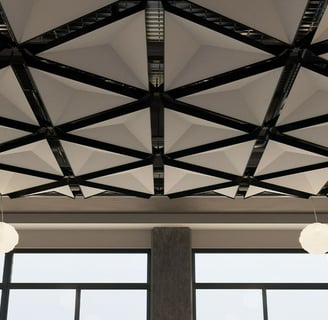CALL TODAY! → (321) 442-6490
The Benefits of Acoustic Ceilings in Commercial Spaces
Say goodbye to echo and exposed pipes. Discover how acoustic ceilings improve sound and aesthetics. Perfect for modern commercial interiors.
5/3/20254 min read


Understanding Acoustic Ceilings
Acoustic ceilings, also known as acoustic ceiling tiles, are specialized ceiling systems designed to enhance sound quality and reduce noise within commercial environments. These ceilings function by absorbing sound waves, thereby minimizing echoes and creating a quieter atmosphere, which is particularly beneficial in bustling workspaces such as offices, restaurants, and educational facilities. The primary goal of an acoustic ceiling is to improve speech intelligibility and provide a comfortable auditory experience for occupants.
There are various types of acoustic ceilings available, each made from different materials and suited to specific needs. Commonly used materials for acoustic ceiling tiles include mineral fiber, fiberglass, and foam. These materials are engineered to provide optimal sound absorption properties, contributing significantly to a reduction in ambient noise. Additionally, they can also improve thermal insulation, making them a dual-purpose solution in commercial settings.
Acoustic ceilings are constructed using grid systems that enable easy installation and maintenance. These grid systems can be either exposed or concealed, depending on the desired aesthetic of the space. Exposed grids showcase the structural design, while concealed grids provide a seamless appearance. Furthermore, acoustic ceiling tiles can be customized in terms of thickness, density, and texture, allowing businesses to tailor their ceiling solutions according to their specific needs and design preferences.
Incorporating acoustic ceilings within commercial spaces can lead to an increase in productivity, employee satisfaction, and overall comfort. By lessening noise pollution and enhancing sound quality, businesses can create an environment conducive to focus and collaboration. Ultimately, the selection of acoustic ceiling systems should be guided by the unique demands of the workspace, ensuring an effective balance between functionality and design.
Improving Acoustics and Reducing Noise Pollution
In commercial environments, effective sound control is paramount for enhancing productivity and comfort. Acoustic ceilings play a pivotal role in this aspect by significantly reducing noise pollution. High levels of noise can hinder communication, create stressful work environments, and diminish overall employee efficiency. By incorporating acoustic ceiling systems, businesses can create spaces that promote better sound management and overall well-being.
Research indicates that excessive noise in workplaces can lead to decreased concentration, increased errors, and heightened frustration among employees. According to a study by the Environmental Protection Agency (EPA), noise pollution in office settings can reduce productivity by up to 66% due to distractions and the inability to focus. Acoustic ceilings address these issues by absorbing sound waves, thus minimizing reverberation and echo. This enhancement in sound quality is essential for improving speech intelligibility, which is vital for effective communication in team settings.
Moreover, acoustic ceilings are not only beneficial in office spaces but also in retail environments. A case study conducted in several retail locations found that implementing acoustic treatments resulted in favorable shopping experiences, as customers reported feeling more comfortable and engaged in a quieter atmosphere. This improvement in the acoustic environment ultimately led to an increase in sales and customer satisfaction, demonstrating that sound management can significantly influence business performance.
Furthermore, modern acoustic ceiling systems are available in a variety of materials and designs, providing flexibility in aesthetic appeal while ensuring functionality. Whether for large open spaces or smaller rooms, these solutions effectively mitigate noise pollution while enhancing the overall acoustic quality of the environment. The integration of acoustic ceilings thus stands as a critical investment for businesses seeking to foster a more productive and pleasant atmosphere.
Aesthetic Enhancements for Commercial Interiors
Acoustic ceilings serve a dual purpose in commercial spaces by improving sound quality while simultaneously offering aesthetic enhancements that contribute significantly to the overall design appeal. The integration of these ceilings can transform various environments, including retail shops, offices, and hospitality venues, making them more pleasing to the eye while maintaining functionality. The versatility of acoustic ceiling design options allows for a seamless blend with existing interior elements, ensuring that any space can achieve a cohesive look.
One of the primary aspects of acoustic ceilings is their variety in color and texture. From muted hues that promote a calming atmosphere in healthcare facilities to vibrant tones that enliven retail spaces, the right color choice can evoke desired emotions in customers and employees alike. Textured acoustic panels can also add depth and interest, creating visual focal points that capture attention. For example, a ceiling featuring geometric patterns can reinforce a modern aesthetic, while organic textures might be more fitting for establishments seeking a natural ambiance.
Moreover, businesses can customize ceiling designs to align with their branding strategies. By incorporating logos or unique patterns into the acoustic ceiling, a company can strengthen its identity while enhancing its space. Integrating such elements contributes to a more inviting atmosphere for both customers and employees, influencing how they perceive the establishment. As a feature that merges form and function, acoustic ceilings certainly elevate the aesthetic experience in commercial interiors, marrying auditory comfort with visual appeal. The thoughtful selection of design elements transforms the mundane into an engaging space, showcasing how soundproofing solutions can enhance overall design.
Choosing the Right Acoustic Solutions for Your Industry
When selecting acoustic ceilings for commercial spaces, it is essential to consider the specific requirements of each industry to achieve optimal sound absorption and aesthetic appeal. Different environments, such as offices, restaurants, and retail spaces, have distinct acoustic needs that can significantly influence productivity and customer experience.
In office settings, where communication and concentration are paramount, acoustic ceiling tiles made from sound-absorbing materials like mineral fiber or fiberglass offer superior noise reduction. These materials effectively dampen ambient noise, creating a quieter work environment. Additionally, tiles with high Noise Reduction Coefficients (NRC) help meet the demands of modern office layouts often characterized by open spaces. To enhance both aesthetics and functionality, choose tiles that integrate seamlessly with existing design elements while providing adequate sound control.
Restaurants, on the other hand, require acoustic solutions that not only manage sound but also contribute to the dining atmosphere. Opting for suspended ceiling systems that use acoustic panels can minimize echoes and background noise, thereby promoting a more enjoyable dining experience. Materials such as wood, fabric-wrapped panels, or special acoustic plaster can add a unique charm to the establishment. Ensuring these installations are easy to clean and maintain will sustain their performance and appearance over time.
In retail environments, maintaining a balanced acoustic ambience while highlighting merchandise is crucial. Ceilings featuring acoustic tiles with reflective properties can enhance sound distribution without compromising on design. Selecting durable tiles that can withstand the rigors of foot traffic and easy maintenance is vital in these high-traffic areas.
For successful installation and long-lasting performance of acoustic ceilings, professional assistance is often recommended, particularly for intricate grid systems. Regular maintenance checks, including cleaning and inspection for damage, will ensure the acoustic solutions continue to meet their intended purposes over time.
SUBSCRIBE TO OUR NEWSLETTER
CALL:
(321) 442-6490
HOURS:
Mon-Sat
9:00am-5:00pm
COPYRIGHT © 2025 L&M Drywall And Framing INC.


